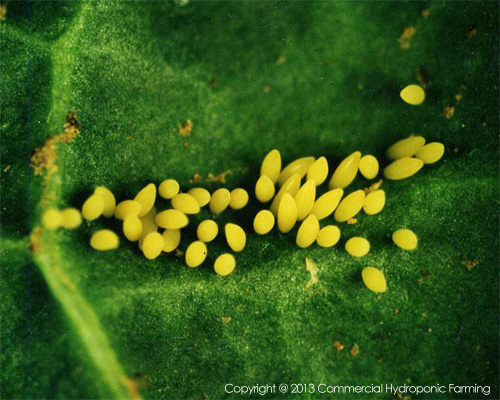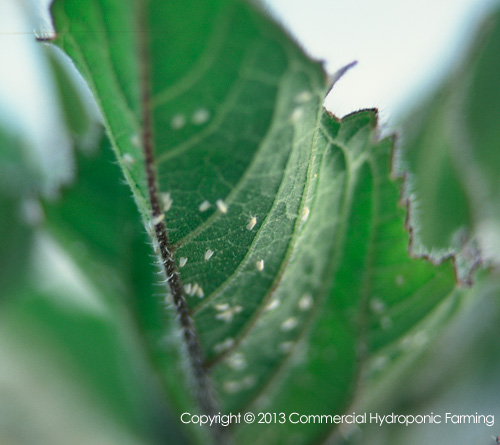Whiteflies in greenhouses
Description of whiteflies
Whiteflies are about 1.5mm long, the adult is white which resembles a tiny moth. They produce oblong eggs, pale green to purple and are inserted into the lower leaf surface, often in a circle or a crescent. Each egg is about 0.2 mm long. The tiny, first instar nymphs are yellow with red eyes and have functional legs and antennae. Second and third instar nymphs are flattened, immobile scale-like insects. The pupa are about 0.75 mm long, the oval, flattened pupa is a pale green (normal) or black (parasitized) insect with long hairs on its back and around its body margin. After the adult has emerged, a white, almost transparent pupal skin is left behind.
Greenhouse whiteflies reproduce relatively slowly (one generation every 30 to 45 days), but each female lays about 250 eggs and lives as long as two months. Adults usually are found on the lower surface of new leaves. There they insert their eggs which hatch 5 to 7 days later. New crawlers move about the plant for a day or two, often from leaf to leaf, before inserting their mouthparts to feed. Once this occurs, they probably do not move again until mature. The crawlers moult into later nymphal instars and then into pupae. Finally, a new generation of whitish-yellow adults emerges. They soon are covered with a white waxy bloom.
Biology of whiteflies
Greenhouse whiteflies are worldwide pests of greenhouse-grown ornamentals and vegetables. First discovered in England in 1856, they were found in the north-eastern U.S. in 1870. Tropical Central or Southern America are suggested origins of the greenhouse whitefly.
Greenhouse whiteflies infest a wide variety of ornamental and vegetable crops, and they can survive outdoors during the growing season, particularly in sheltered locations.
Damage done by whiteflies
The nymphs and adults extract plant sap through their needle-like mouthparts, the adults preferring to feed on tender new growth. As a result, leaves turn yellow and drop from infested plants. In addition to having an unthrifty appearance, plants may be stunted and un-reproductive. Sooty mold often grows on leaves covered with honeydew secretions of whiteflies and interfere further with the growth of plants.
Controlling whiteflies
Parasitic wasps, Encarsia formosa, sometimes help keep greenhouse whitefly populations under control. However, at temperatures below 24°C (75 F), the reproduction of these parasites is inhibited. As a result, whitefly infestations are encouraged by lower greenhouse temperatures.
Control of whiteflies is difficult because the eggs and immature forms are resistant to many aerosol and insecticide sprays. One must make regular applications of pesticides to control emerging adults until the last of a whole generation of immature whiteflies has emerged. Methomyl and some of the synthetic pyrethroid and synthetic insect-growth-regulator pesticides, however, are extremely effective and need not be applied as often.

Yellow eggs of whiteflies. Some white flies lay their eggs in clusters and some in circles. (Image: D. van Heerden – used with permission)



